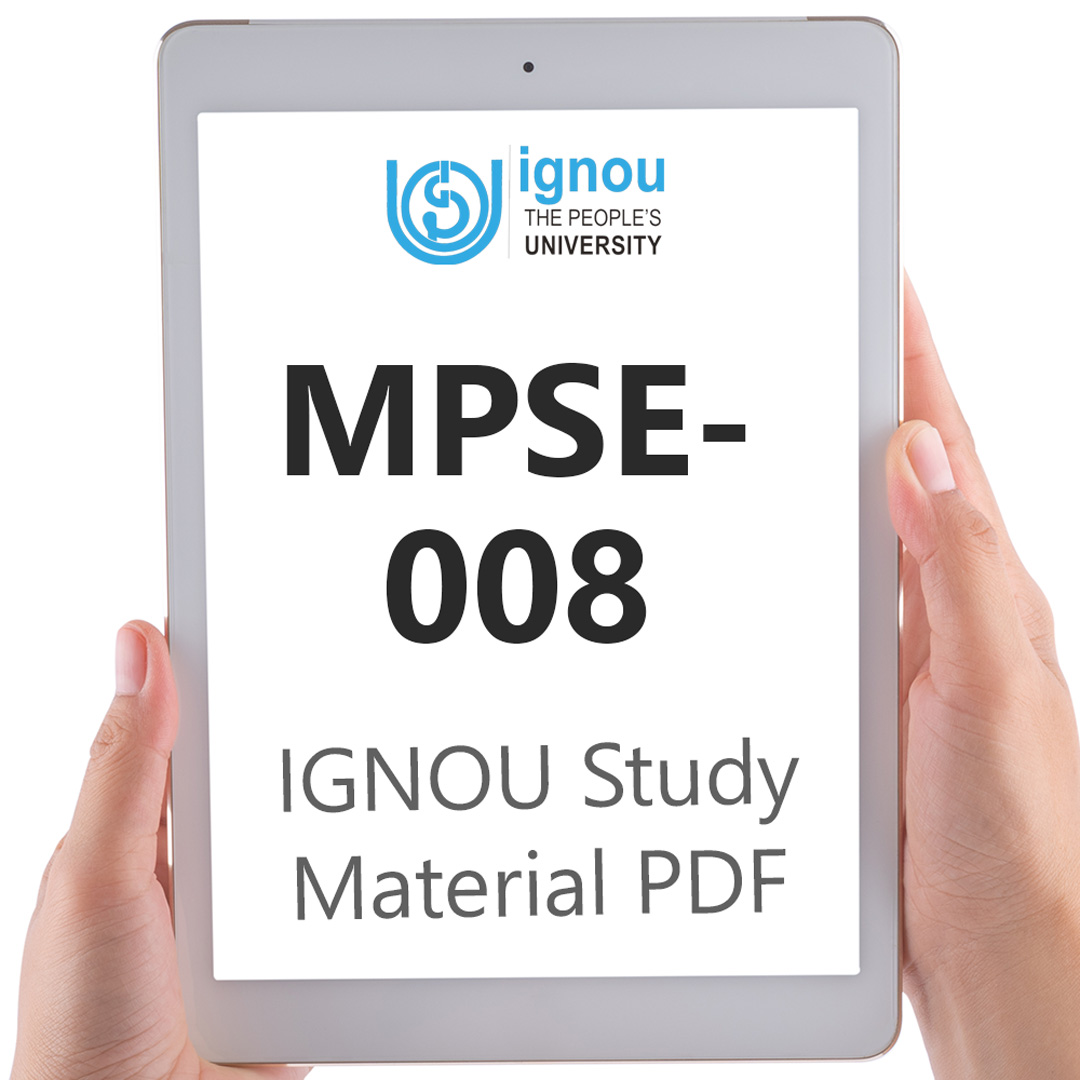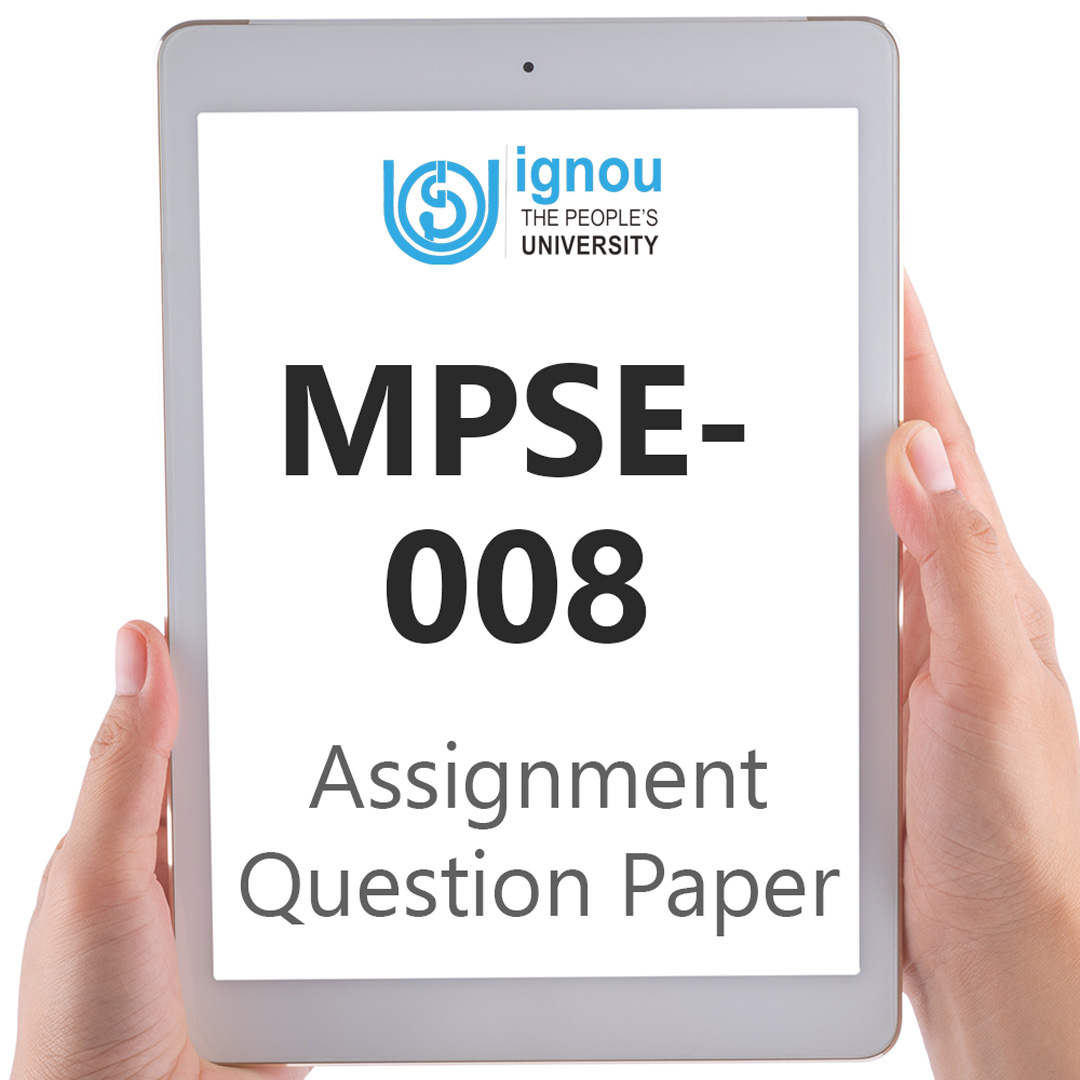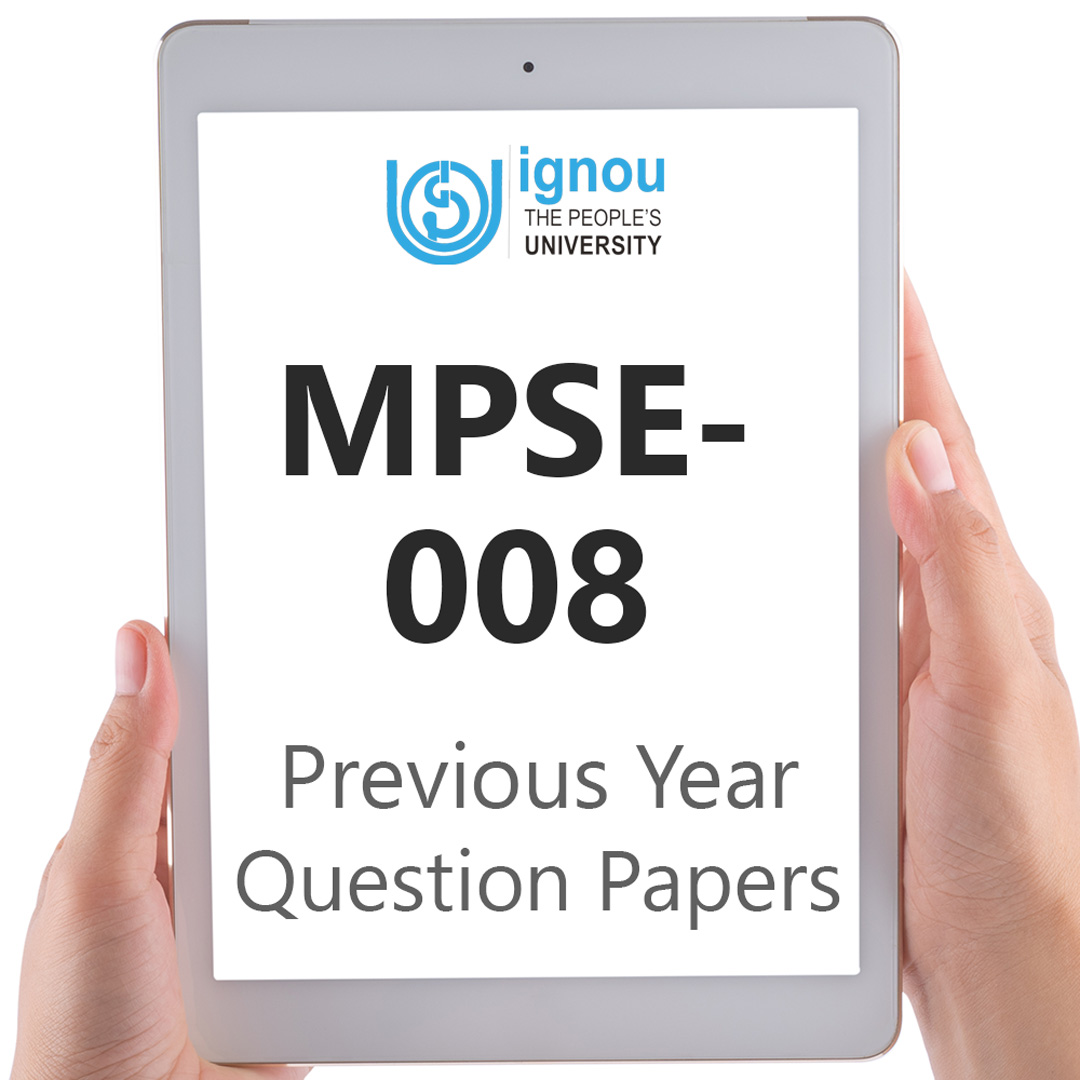If you are looking for MPSE-008 IGNOU Solved Assignment solution for the subject State Politics in India, you have come to the right place. MPSE-008 solution on this page applies to 2023-24 session students studying in MPS courses of IGNOU.
MPSE-008 Solved Assignment Solution by Gyaniversity
Assignment Code: MPSE-008/Asst/TMA/2023-24
Course Code: MPSE-008
Assignment Name: State Politics in India
Year: 2023-2024
Verification Status: Verified by Professor
Answer five questions in all, selecting at least two questions from each section. Each question is to be answered in about 500 words. Each question carries 20 marks.
SECTION-I
Q1) Discuss how different frameworks are applied to the study of identities and new social
movements in state politics.
Ans) The study of identities and new social movements in state politics involves various frameworks that help comprehend the complexities of collective action and identity-based politics. Several approaches and theoretical lenses are applied to understand these dynamics:
a) Identity Politics Framework: Focuses on how identities based on race, ethnicity, gender, religion, caste, and other social markers shape political mobilization. It emphasizes how marginalized, or minority groups organize themselves around shared identities to demand recognition, rights, and representation within the state.
b) Social Movement Theory: Examines the emergence, organization, and strategies of collective action. It explores how social movements mobilize people, frame grievances, and utilize resources to challenge the status quo, bring social change, and influence state policies.
c) Intersectionality: Recognizes the interconnectedness of various social identities and their impact on political mobilization. It acknowledges that individuals embody multiple identities and experiences, and these intersections influence their participation in social movements and political activism.
d) State-Centric Approaches: Analyse the role of the state in responding to social movements and identity-based politics. This framework examines how state policies, institutions, and structures either accommodate or resist the demands of different identity groups.
e) Cultural Studies and Discourse Analysis: Explores the role of language, symbols, and representations in shaping identities and social movements. It examines how cultural narratives and discourses influence the construction of collective identities and impact political mobilization.
f) Globalization and Transnationalism: Considers the influence of global forces on local identity politics and social movements. It examines how global processes, such as migration, media, and transnational activism, shape identities and mobilize communities across borders.
Each framework offers unique insights into the study of identities and new social movements in state politics. Researchers and scholars often combine multiple frameworks to gain a comprehensive understanding of the complexities inherent in these dynamics, acknowledging the multi-layered nature of identity-based politics and the evolving nature of social movements within state contexts.
Q2) The party systems at both levels – national and state moved towards a fragmentation from the late 1980s or, more particularly, from the 1990s. What are the features of these fragmentary systems?
Ans) The fragmentation of party systems at both the national and state levels in India, particularly from the late 1980s and the 1990s, is characterized by several features:
a) Multiparty System: The emergence of numerous political parties, leading to a multiparty system, where power is distributed among several parties. This is a shift from the earlier dominance of a two-party system at the national level.
b) Regionalization of Politics: Increased prominence of regional parties that focus on issues and concerns specific to particular states or regions. Regional parties often play a crucial role in state politics and may form alliances at the national level.
c) Coalition Politics: The era saw a rise in coalition governments at both the national and state levels. No single party has been able to secure a clear majority on its own, leading to the formation of alliances and coalition governments.
d) Decline of Single-Party Dominance: The decline of single-party dominance, as witnessed during the earlier decades after independence, marked by the Indian National Congress's hegemony. Other parties, including regional ones, gained significance, and started playing influential roles.
e) Issue-Based Politics: Parties started aligning and realigning based on specific issues rather than rigid ideological considerations. Issue-based politics became more prevalent, allowing parties to come together or break away based on shared interests or concerns.
f) Social Coalition Politics: Parties began forming alliances based on social and caste considerations to consolidate vote banks. This led to the emergence of identity politics, with parties representing specific caste or community interests.
g) Rise of New Entrants: The political landscape witnessed the entry of new and smaller parties, often formed around charismatic leaders or emerging social issues. These parties could sway the political narrative and impact electoral outcomes.
h) Election Volatility: Increased volatility in electoral outcomes, with parties gaining or losing power in successive elections. Voters exhibited a willingness to experiment with different political formations and were less loyal to any single party.
i) Regional Imbalance: Fragmentation sometimes led to concerns about regional imbalances in political power, with certain states or regions having a disproportionate influence on national politics.
j) Media Influence: The role of media, especially electronic media, became significant in shaping public opinion and influencing electoral outcomes. Parties had to adapt to the changing media landscape to remain relevant.
The features of fragmentary party systems reflect the evolving nature of Indian politics, marked by increased diversity, regionalization, and a departure from the dominance of a single party. The dynamics of coalition politics, social coalition-building, and the influence of identity-based issues have played crucial roles in shaping the contemporary political scenario in India.
Q3) Contextualise the water and territorial disputes in relation to federalism in India.
Ans) Water and territorial disputes often intersect with federalism in India due to the distribution of powers between the central government and states concerning these issues.
a) Water Disputes: India faces several inter-state water disputes over sharing river waters. The Inter-State River Water Disputes Act of 1956 was enacted to resolve these conflicts. However, disagreements persist between states over equitable sharing, often leading to legal battles and the need for central intervention. Resolving these disputes involves navigating federal structures, balancing state autonomy with the need for central arbitration.
b) Territorial Disputes: States occasionally have conflicts over territorial boundaries, leading to disputes. These conflicts can range from border encroachments to disagreements over land demarcations. The resolution of such conflicts requires cooperation between states and central authorities to maintain peace and order.
c) Federal Structure and Conflict Resolution: The Indian federal structure grants certain powers related to water and territories to states while also maintaining the authority of the central government. The role of the Union becomes crucial in resolving disputes between states, often through the intervention of central tribunals or authorities.
c) Federal Structure and Conflict Resolution: The Indian federal structure grants certain powers related to water and territories to states while also maintaining the authority of the central government. The role of the Union becomes crucial in resolving disputes between states, often through the intervention of central tribunals or authorities.
d) Role of Central Institutions: Institutions like the Inter-State Council and expert committees are instrumental in mediating disputes by providing platforms for negotiation and arbitration. However, the effectiveness of these bodies often depends on the willingness of states to adhere to their recommendations.
e) Judicial Intervention: The Indian judiciary, particularly the Supreme Court, has played a significant role in resolving water and territorial disputes between states. It has interpreted federal provisions to determine the allocation of resources and boundaries, serving as an arbiter in inter-state conflicts.
f) Challenges and Balance: Balancing state autonomy with the need for central intervention poses a significant challenge in federal governance. While states advocate for their interests, the central government must ensure equitable solutions that benefit all stakeholders.
Overall, these disputes within a federal framework underscore the delicate balance between decentralization and centralization in India's governance. Addressing water and territorial disputes necessitates a cooperative and balanced approach between the Centre and the states to maintain harmonious federal relations.
SECTION-II
Write a short note on each part of the following question in about 250 words:
Q4a) Patterns of protest movements
Ans) Protest movements are diverse expressions of dissent that challenge existing norms, policies, or power structures. The patterns of protest movements vary based on their objectives, strategies, and the socio-political context. Here are key aspects of the patterns observed in protest movements:
a) Objective Diversity: Protest movements can emerge for a myriad of reasons, including socio-economic inequalities, political repression, environmental concerns, or cultural issues. The objectives of a protest movement shape its nature, demands, and the extent of societal impact.
b) Tactics and Strategies: Protest movements employ a range of tactics, from peaceful demonstrations and civil disobedience to more confrontational methods. The choice of strategy often depends on the movement's goals, the level of public support, and the nature of the opposition. Movements may also use digital platforms for organizing and amplifying their messages.
c) Social Media and Connectivity: In contemporary times, social media has become a powerful tool for mobilizing and organizing protests. Movements leverage platforms like Twitter, Facebook, and Instagram to connect with like-minded individuals, share information, and garner public support. This digital dimension has altered the dynamics of protest patterns.
d) Globalization of Movements: Protest movements increasingly transcend national boundaries. Globalization allows movements to draw inspiration from and collaborate with similar struggles worldwide. Examples include the global climate change protests inspired by Greta Thunberg and the Occupy Wall Street movement that resonated globally.
e) Identity-based Movements: Many contemporary protests are driven by issues related to identity, including gender, race, ethnicity, and sexual orientation. Movements such as Black Lives Matter, #MeToo, and LGBTQ+ rights movements are characterized by their focus on challenging systemic inequalities and discrimination.
Q4b) India’s policy of economic reforms
Ans) India's policy of economic reforms refers to the series of measures undertaken to liberalize and transform the country's economic structure, particularly starting in the early 1990s. The reforms aimed to dismantle the centrally planned economic system, foster private sector participation, and integrate India into the global economy. Here are key aspects of India's economic reforms:
a) Liberalization: The reforms initiated liberalization measures, reducing government control over various sectors. Industrial licensing was significantly relaxed, allowing for greater private sector participation. Trade barriers were reduced to encourage foreign investment and boost international trade.
b) Privatization: Another crucial aspect was privatization, involving the sale of state-owned enterprises. The objective was to enhance efficiency, reduce bureaucratic control, and inject competition into sectors that were previously monopolized by the public sector.
c) Globalization: Economic reforms sought to integrate India into the global economy. This involved opening up the economy to foreign direct investment (FDI) and encouraging trade liberalization. The government aimed to make Indian industries more competitive on the global stage.
d) Financial Sector Reforms: The financial sector underwent significant changes. Banking and financial institutions were restructured to improve efficiency, transparency, and competitiveness. The stock markets were also liberalized, allowing for greater participation from investors.
e) Fiscal Reforms: The government undertook fiscal reforms to rationalize tax structures and improve fiscal discipline. The introduction of the Goods and Services Tax (GST) in 2017 was a landmark step toward creating a unified and transparent taxation system.
f) Impact on Growth: One of the primary goals of economic reforms was to stimulate economic growth. Over the years, India experienced a notable increase in GDP growth rates, and sectors such as information technology, telecommunications, and services flourished.
Q5a) Efforts made for electoral reforms
Ans) Efforts towards electoral reforms in India have been ongoing to enhance the fairness, transparency, and representativeness of the electoral process. Here's a brief overview:
a) Formation of Election Commission: The establishment of the Election Commission of India (ECI) in 1950 was a crucial step. The ECI is an autonomous constitutional authority responsible for administering election processes and enforcing electoral laws.
b) Anti-Defection Law: The 10th Schedule of the Constitution, commonly known as the Anti-Defection Law, was introduced in 1985 to curb political defections and promote stability. This law disqualifies legislators who defect from their party.
c) Introduction of Electronic Voting Machines (EVMs): The adoption of EVMs in the 1990s aimed to eliminate fraudulent practices like booth capturing and manipulation of ballot papers. EVMs have enhanced the speed and accuracy of the voting process.
d) Voter-Verified Paper Audit Trail (VVPAT): In recent years, the ECI has introduced VVPATs to provide a physical verification of the vote cast by generating a paper slip. This enhances voter confidence and allows for manual verification if needed.
e) State Funding of Elections: There have been discussions about state funding of elections to reduce the influence of money power in politics. This involves providing funds to political parties from the state exchequer to minimize dependence on private donations.
f) Limit on Expenditure: Efforts have been made to regulate election expenditures by imposing limits on the amount a candidate or political party can spend during election campaigns. This is aimed at reducing the role of money in elections.
g) Representation of Women: Various proposals and demands have been made to increase the representation of women in legislative bodies. The Women's Reservation Bill, which proposes to reserve one-third of seats for women in the Lok Sabha and state assemblies, is one such initiative.
Q5b) Decline of Congress system
Ans) The decline of the Congress system in Indian politics denotes the erosion of the Indian National Congress's (INC) dominant position in the political landscape post-independence. Here's an overview:
a) Emergence of Opposition: Initially, the INC enjoyed hegemony due to its pivotal role in the freedom struggle and the absence of a formidable opposition. However, starting from the late 1960s and early 1970s, several factors contributed to the emergence of a credible opposition, challenging the Congress's supremacy.
b) Internal Struggles: Internal factions within the Congress, differences in ideology, and leadership conflicts weakened the party. The split in the party in 1969 leading to the formation of Congress (O) and Congress (R) factions and subsequent factionalism was a pivotal moment.
c) Regionalization of Politics: The rise of regional parties and the strengthening of regional identities in various states diverted support away from the Congress. The emergence of strong regional leaders like M.G. Ramachandran in Tamil Nadu, N.T. Rama Rao in Andhra Pradesh, and others played a significant role.
d) Economic and Social Changes: Rapid socio-economic changes, especially post the economic reforms in the 1990s, brought about aspirations and demands of various social groups, leading to new political alignments and challenging the Congress's hold.
e) Coalition Politics: The era of coalition politics replaced the single-party dominance. The Congress began to lead coalition governments at the center, and no longer commanded an absolute majority as it did in the past.
f) Electoral Losses: The decline was reflected in electoral losses, with the Congress facing setbacks in several state elections and experiencing a decline in its vote share and number of seats in the Lok Sabha.





